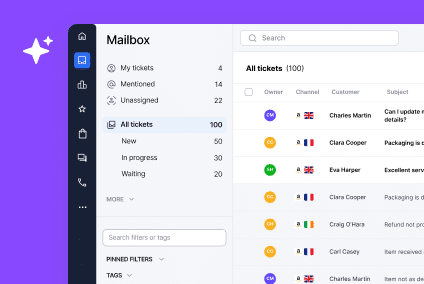Just like a classic car, a well-aged whiskey or that little black dress, superior customer service never goes out of style. Companies like Apple, Amazon, and Zappos are well-known and well-respected for their excellent customer service.
In fact, it’s been this attention to detail and focus on the customer experience that has helped each of these companies rise head and shoulders above their competitors to scale and maintain their positions as market leaders globally.
Focusing on personalized and highly attentive customer service helps drive customer loyalty and directly correlates with a company’s public perception and financial success. While good customer service is a stalwart of industry, every year brings new and improved ways for businesses to adapt their customer service to enable further success.
Inspired by most businesses’ desire to achieve even better customer service levels, these seven top customer support trends are at the forefront for 2025.
Businesses taking on these trends are already ahead of the curve, and those who aren’t should take note …because doing so might just make this year your most successful year ever.
7 Top Customer Support Trends for 2021
1. AI-Powered Customer Service Revolution
Artificial intelligence has fundamentally transformed customer service, with 80% of customer service and support organizations using generative AI (GenAI) to improve agent productivity and overall customer experience, according to Gartner. This represents a massive shift from basic chatbots to sophisticated AI agents capable of handling complex customer interactions.
AI-powered customer service tools are delivering remarkable results. Early adopters are seeing 80% savings in the time it takes to create a case summary, and agents spending 80% less time typing when resolving a support request. Companies implementing AI customer service solutions are experiencing average returns of $3.50 for every $1 invested, making this one of the most impactful eCommerce customer service trends of 2025.
The future of customer support is increasingly automated, with 95% of customer interactions predicted to be handled by AI by 2025. This doesn’t mean replacing human agents entirely, but rather empowering them with customer support trends software that handles routine inquiries while allowing staff to focus on complex, high-value interactions.
You can implement this trend into your 2025 strategy by investing in AI-powered helpdesk solutions that integrate with your existing systems. Look for platforms that offer intelligent ticket routing, automated responses for common questions, and sentiment analysis to identify customer emotions and urgency levels.
2. Hyper-Personalization Through Data Intelligence
Moving beyond basic personalization, 2025 sees the rise of hyper-personalization in customer support. 71% of consumers expect companies to deliver personalized interactions, while 76% of customers get frustrated when they don’t receive personalized experiences.
Modern customer support trends tools now leverage comprehensive customer data to create truly individualized experiences. This includes analyzing purchase history, browsing behavior, communication preferences, and interaction patterns to provide contextually relevant support.
Companies using APIs (Application Programming Interface) are 21% faster when solving customers’ problems, enabling seamless data integration across all touchpoints. This technological foundation allows support agents to access complete customer profiles instantly, improving customer service delivery significantly.
Digital customer service solutions now incorporate predictive analytics to anticipate customer needs before issues arise. This proactive approach to customer support best practices ensures that businesses can address potential problems before they impact the customer experience.
By working with a customer data platform that centralizes information from all customer touchpoints, you’ll be able to deliver the kind of personalized support that builds lasting customer relationships and drives business growth.
3. Omnichannel Experience as Standard
Omnichannel support has evolved from a competitive advantage to an essential requirement. 47% of eCommerce decision-makers in Europe and North America consider omnichannel strategies to be very important for their business, with customers expecting seamless transitions between channels without losing context.
The future of customer support demands that all customer touchpoints work together harmoniously. Whether customers start a conversation via social media, continue through live chat, and resolve through email, they expect consistent, informed service at every step.
Modern customer support trends software integrates multiple communication channels into unified platforms, ensuring that customer service representatives have complete visibility into every customer interaction. This integration is crucial for maintaining context and providing efficient resolution.
71% of Gen Z would now reach out to customer support via a live phone call, showing that even digital natives value traditional channels when properly integrated into a comprehensive omnichannel strategy.
You can achieve this by implementing cloud-based customer service platforms that integrate with CRM systems and provide real-time information sharing across all channels. This creates a single view of each customer and enables your team to deliver consistently excellent service regardless of the communication method.
4. Self-Service and Autonomous Customer Support
Self-service capabilities have become central to improving customer service strategies. 81% of customers attempt to resolve issues themselves before reaching out to a live representative, while 69% of customers prefer to use self-service options like a knowledge base or chatbot over contacting support.
Advanced self-service solutions powered by AI are transforming how customers interact with support resources. Companies that use AI chatbots for customer service see a 30% reduction in support costs while simultaneously improving customer satisfaction through instant availability.
The most effective digital customer service solutions now include comprehensive knowledge bases, interactive troubleshooting guides, and AI-powered virtual assistants that can handle complex queries. Self-service portals can reduce support call volumes by 25-30%, allowing agents to focus on more complex queries.
Modern customer support trends tools are incorporating visual elements, video tutorials, and step-by-step interactive guides that make self-service more intuitive and effective than ever before. This approach aligns with customer preferences while optimizing resource allocation.
Consider implementing a robust self-service platform that includes searchable knowledge bases, community forums, and AI-powered chat assistance. These tools should be easily accessible from your website and mobile app, providing customers with instant access to solutions.
5. Proactive Customer Experience Management
The shift from reactive to proactive customer service represents one of the most significant customer support best practices for 2025. 96% of consumers trust a brand more when companies make it easy to do business with them, and proactive service is key to achieving this trust.
Proactive customer support involves identifying and addressing potential issues before customers even realize they exist. This approach uses predictive analytics, monitoring systems, and customer behavior data to anticipate needs and prevent problems.
Advanced customer support trends software now includes automated monitoring that can detect service disruptions, shipping delays, or product issues and automatically notify affected customers with solutions. This approach transforms potential negative experiences into positive touchpoints.
The future of customer support includes predictive maintenance notifications, personalized product recommendations based on usage patterns, and automated follow-ups to ensure customer satisfaction. These proactive measures significantly improve customer retention and loyalty.
Businesses implementing proactive customer service strategies report higher customer satisfaction scores and reduced support ticket volumes. The key is investing in systems that can analyze customer data in real-time and trigger appropriate automated responses.
6. Enhanced Agent Experience and AI Collaboration
While automation handles routine tasks, the importance of skilled human agents has never been higher. 72% of CX leaders say they’ve provided adequate training for generative AI tools, but 55% of agents say they haven’t received any training, highlighting the need for better integration between human expertise and AI capabilities.
Modern improving customer service strategies focus on empowering agents with AI-powered tools that enhance their capabilities rather than replace them. These tools provide instant access to customer information, suggest responses based on similar cases, and offer real-time guidance during complex interactions.
The most successful customer support implementations create collaborative environments where AI handles data gathering and initial analysis while human agents focus on relationship building, complex problem-solving, and emotional support.
83% of customers feel more loyal to brands that listen and resolve their complaints, emphasizing that the human element remains crucial for building lasting customer relationships. The future of customer support lies in optimizing the collaboration between AI efficiency and human empathy.
You can achieve this by providing comprehensive training programs that help your team understand how to work effectively with AI tools. Invest in platforms that augment human capabilities rather than trying to replace them entirely. Providing adequate training so that they have the tools they need to stay on top of their game will help them feel ownership and take pride in their work
7. Data-Driven Customer Support Optimization
The future of customer support relies heavily on data analytics and continuous optimization. A one-point increase in customer satisfaction can increase shareholder value by 1%, making data-driven improvements directly tied to business success.
Modern customer support trends tools include sophisticated analytics capabilities that track everything from response times and resolution rates to customer sentiment and agent performance. This data enables continuous improvement and evidence-based decision making.
Advanced analytics also power predictive insights that help businesses understand customer behavior patterns, identify potential churn risks, and optimize resource allocation. These insights are crucial for developing effective customer support best practices.
90% of customers say a quick response is critical when they have a question, with 60% expecting “immediate” to mean within 10 minutes. Data analytics helps businesses understand and meet these escalating expectations through optimized workflows and strategic resource deployment.
The most effective digital customer service solutions integrate with business intelligence platforms, providing comprehensive dashboards that track key performance indicators and identify opportunities for improvement.
To implement this trend, invest in customer support trends software that provides robust reporting and analytics capabilities. Use this data to continuously refine your processes, optimize response times, and enhance overall customer satisfaction.
Final Thoughts
Customer service is continuously growing and evolving, with exciting new technologies powering the possibilities of what you can offer your customers by improving the customer journey.
One thing is for sure, and that is that, in addition to purchases from brick-and-mortar stores, we will continue to see more people shopping online than ever before.
Today’s customer is more connected than ever and demands instant service, which brands are well-placed to offer through innovative technologies. So, there’s never been a better time to implement new technologies and try new tactics to provide excellent customer service. Doing so could make this year your best year of sales yet!
The trends outlined above represent the future of customer support, combining artificial intelligence, data analytics, and human expertise to create exceptional customer experiences. By embracing these eCommerce customer service trends and investing in the right customer support trends tools, businesses can build lasting relationships with their customers while optimizing operational efficiency.
For businesses looking to implement these trends, explore how AI can transform your eCommerce operations and discover comprehensive customer service solutions that align with 2025’s best practices. To see how modern customer support platforms can help you stay ahead of these trends, try eDesk for free and experience the future of customer service technology.




